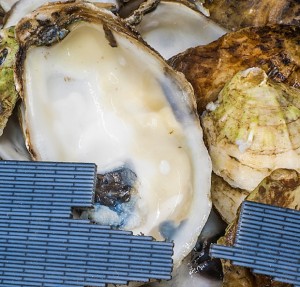
 The brick-and-mortar pattern of MIT’s simulated bone and nacre material doesn’t look much like the real thing. Credit: M. Buehler/MIT; photo by Graham Bratzel.
The brick-and-mortar pattern of MIT’s simulated bone and nacre material doesn’t look much like the real thing. Credit: M. Buehler/MIT; photo by Graham Bratzel.
For an observer of science and technology topics (OK, for this observer, anyway), it can be fascinating to watch how the fertile minds of researchers work to combine multiple technologies, which then morph into new and unexpected developments.
An example involves a synthesis of computational materials science, 3D printing, and bioinspired materials engineering. CTT has recently published reports on the latter two topics: an article outlining possible use of 3D printing in construction and one on nature’s ingenious structural materials designs. Now researchers at the Massachusetts Institute of Technology (Cambridge) are using both concepts to design and test materials that duplicate or exceed the strength and toughness of natural materials.
Bone is an example of a natural structural material that is a composite of hydroxyapatite and collagen. According to this news release, the challenge in duplicating its properties lies in the way the two materials are arranged: the complex structure changes “at every scale of the composite, from the micro up to the macro.” Scientists at MIT’s Department of Civil and Environmental Engineering have pioneered an approach that allows them to formulate new materials based on the “complex, hierarchical structures” of natural materials like bone or mother of pearl using computational modeling, then use 3D printing to quickly create physical samples of the simulated materials for testing and verification of computed properties.
Associate professor Markus Buehler and coworkers used a 3D printer capable of working with two or more materials at once to create “computer-optimized designs of soft and stiff polymers placed in geometric patterns that replicate nature’s own patterns,” the release said.
“The geometric patterns we used in the synthetic materials are based on those seen in natural materials like bone or nacre, but also include new designs that do not exist in nature,” Buehler said in the release. “We can design our own, which may perform even better than the ones that already exist.”
The materials don’t appear at all like their natural counterparts. The scientists’ 3D printed bone-like material, for example, features a microscopic pattern similar to a brick wall, with stiff blue polymer bricks and a soft black polymer “mortar.” Turning to 3D printing, the authors used the two polymers to fabricate composites with three configurations based on their computational model: a bone-like structure with stiff platelets “mortared” with the soft polymer, a calcite-type structure where the stiff and soft polymers alternate in columns, and a rotated bone-like structure where the stiff constituent is shaped like a diamond instead of a rectangular brick (which increased flexibility of the composite). They subjected each of three composite samples to tensile and other mechanical testing, which validated their computational models and simulation process. “Most importantly, the experiments confirmed the computational prediction of the bonelike specimen exhibiting the largest fracture resistance,” said graduate student Leon Dimas, the lead author on the paper. “And we managed to manufacture a composite with a fracture resistance more than 20 times larger than its strongest constituent.”
According to the release, the composite 3D printing process “could be scaled up to provide a cost-effective means of manufacturing materials that consist of two or more constituents, arranged in patterns of any variation imaginable and tailored for specific functions in different parts of a structure.”
“The possibilities seem endless, as we are just beginning to push the limits of the kind of geometric features and material combinations we can print,” Buehler concluded.
Results of the work are reported in “Tough composites inspired by mineralized natural materials: computation, 3D printing, and testing,” by Leon S. Dimas, Graham H. Bratzel, Ido Eylon, and Markus J. Buehler, recently published online in Advanced Functional Materials (DOI:10.1002/adfm.201300215).
